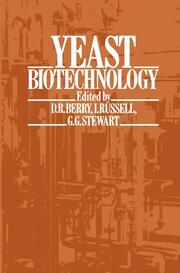-
Zusatztext
-
Biotechnology Biotechnology is is now now established established as as a a major major area area of of technology, technology, concerned concerned with with the' the' application application of of biological biological organisms, organisms, systems systems or or processes processes to to manufac turing turing or or service service industries'. industries'. Although Although the the exploitation exploitation of of organisms organisms by by man man is is not not new, new, many many of of the the techniques techniques which which are are stimulating stimulating the the rapid rapid advances advances in in biotechnology biotechnology have have developed developed from from recent recent scientific scientific discoveries. discoveries. Throughout Throughout history history man man has, has, knowingly knowingly or or not, not, been been exploiting exploiting yeast yeast in in the the production production of of alcoholic alcoholic beverages beverages and and bread, bread, and and these these processes processes still still represent represent major major biotechnological biotechnological industries. industries. The The brewer's brewer's and and baker's baker's yeast yeast Sac charomyces charomyces cerevisiae cerevisiae is, is, however, however, also also a a favoured favoured organism organism for for the the production production of of many many new new biotechnological biotechnological products. products.
-
-
Autorenportrait
- InhaltsangabeI Yeast identification and maintenance.- 1 Maintenance of yeast cultures.- 1.1 Introduction.- 1.2 Yeast preservation.- 1.3 Collection management.- 1.4 Service collections of yeasts.- References.- 2 Approaches to yeast identification.- 2.1 Introduction.- 2.2 Yeast classification.- 2.3 General identification methods.- 2.4 Identification of industrial contaminants.- 2.5 Concluding remarks.- Acknowledgements.- References.- II Genetic manipulation.- 3 Classical genetic and protoplast fusion techniques in yeast.- 3.1 Introduction.- 3.2 Whole-cell hybridization.- 3.3 Mutation.- 3.4 Protoplast (spheroplast) fusion.- 3.5 Electrofusion.- 3.6 Conclusions.- Acknowledgements.- References.- 4 Yeast plasmids and transformation.- 4.1 Introduction.- 4.2 The yeast 2-?m plasmid.- 4.3 Chromosomal ARS-containing plasmids.- 4.4 All-yeast DNA vectors.- 4.5 Minichromosomes.- 4.6 Integrating plasmids.- 4.7 Plasmids carrying dominant selectable markers.- 4.8 Expression vectors.- 4.9 Transformation.- 4.10 Summary.- Acknowledgements.- References.- 5 dsRNA killer systems in yeast.- 5.1 Introduction.- 5.2 Frequency and distribution in nature.- 5.3 Killer toxins.- 5.4 ScV particles.- 5.5 dsRNA transcription and replication.- 5.6 L dsRNA species.- 5.7 M dsRNA species.- 5.8 Practical applications.- 5.9 Concluding remarks.- Acknowledgements.- References.- III Growth of yeast.- 6 Physiology of yeast growth.- 6.1 Introduction.- 6.2 Yeast nutrition.- 6.3 Substrate assimilation.- 6.4 Modes of yeast growth.- 6.5 Yeast metabolism.- 6.6 Glycerol formation.- 6.7 RQ as a guide to metabolic state.- 6.8 Ethanol toxicity.- 6.9 Storage carbohydrates.- 6.10 Growth of genetically engineered yeast.- References.- 7 The technology of aerobic yeast growth.- 7.1 Introduction.- 7.2 Baker's yeast.- 7.3 Fodder (feed) yeast.- 7.4 Yeast enzymes and other intracellular yeast components.- 7.5 Genetically engineered products 223 Acknowledgements.- Acknowledgements.- References.- 8 The technology of anaerobic yeast growth.- 8.1 Introduction.- 8.2 Ethanol production using freely suspended yeast cells.- 8.3 Ethanol production using immobilized yeast cells.- 8.4 The production of alcoholic beverages using different bioreactor systems.- 8.5 Conclusions.- Acknowledgements.- References.- 9 Biochemical and genetic control of sugar and carbohydrate metabolism in yeasts.- 9.1 Introduction.- 9.2 D-Galactose.- 9.3 Maltose and maltotriose.- 9.4 Sucrose.- 9.5 Melibiose.- 9.6 Lactose.- 9.7 Dextrin and starch.- 9.8 Cellulosic materials.- 9.9 Conclusions.- Acknowledgements.- References.- 10 Substrate utilization, non-carbohydrate substrates.- 10.1 Yeasts capable of growth on non-carbohydrate substrates.- 10.2 Non-carbohydrate substrates which will support growth of yeast.- 10.3 Metabolism of methylotrophic yeasts.- 10.4 Metabolism of n-alkane-assimilating yeasts.- 10.5 Metabolism of ethanol.- 10.6 Single-cell protein production.- 10.7 Citrate production.- 10.8 L-Malic acid production.- 10.9 Other products.- 10.10 Final conclusion.- References.- IV Product formation.- 11 Production of organoleptic compounds.- 11.1 Introduction.- 11.2 Yeast organoleptic compounds.- 11.3 Higher alcohols.- 11.4 Organic acids.- 11.5 Esters.- 11.6 Carbonyls.- 11.7 Sulphur compounds.- 11.8 Miscellaneous compounds.- 11.9 Conclusions.- References.- 12 Hydrolytic enzymes.- 12.1 Introduction.- 12.2 Enzyme synthesis and secretion.- 12.3 Glycoside hydrolases.- 12.4 Phosphoric monoester hydrolases.- 12.5 Carboxylic ester hydrolases.- 12.6 Peptide hydrolases.- 12.7 Concluding remarks.- Acknowledgements.- References.- 13 Expression and secretion of foreign polypeptides in yeast.- 13.1 Introduction.- 13.2 Yeast transformation.- 13.3 Plasmid systems.- 13.4 Expression vectors.- 13.5 Regulated systems.- 13.6 Factors affecting heterologous protein production.- 13.7 Secretion.- 13.8 Products.- References.- V Downstream processing.- 14 The isolation and purification of protein and peptide products.- 14.1 Introduction.- 14.2 Techniques of yeast
Detailansicht
Yeast Biotechnology
ISBN/EAN: 9780045740420
Umbreit-Nr.: 1525815
Sprache:
Englisch
Umfang: xx, 540 S.
Format in cm:
Einband:
gebundenes Buch
Erschienen am 30.11.1987


